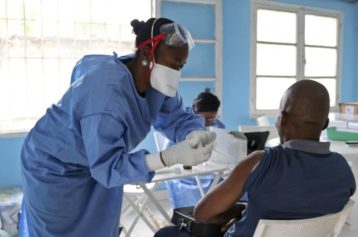Ebola was first discovered nearly 40 years ago in Africa, so why are we now only starting to see the first signs of a possible drug to treat the deadly disease? Two words: racism and greed.
Though the disease has crept its way into our imaginations across the globe and has become a synonym for instant bodily terror, like a scene from a horror flick, the private pharmaceutical industry has shown very little interest in putting money behind the research needed to find a cure. That’s because the disease has thus far been contained in Africa, in countries filled with poor, dark people. For-profit companies see very little upside in aggressively expending resources under such circumstances. There’s much more money to be made going after drugs to treat erectile dysfunction or baldness.
In other words, ailments that can affect white men.
According to the latest numbers released Thursday, more than 1,900 people have died from this latest Ebola outbreak in West Africa. There have been other deadly outbreaks over the last 40 years, but none as bad as this one.
Some may want to play a numbers game, concluding that although Ebola is about as scary a specter as the germ world has ever thrown at humans, its numbers are still relatively tiny. But you should consider this point made in a recent issue of The New Yorker:
“Diseases like malaria and tuberculosis, which together kill two million people a year, have received less attention from pharmaceutical companies than high cholesterol,” the magazine reported. “Then, there’s what the World Health Organization calls ‘neglected tropical diseases,’ such as Chagas disease and dengue; they affect more than a billion people and kill as many as half a million a year. One study found that of the more than fifteen hundred drugs that came to market between 1975 and 2004, just ten were targeted at these maladies.”
In other words, if the pharmaceuticals want big numbers, malaria and dengue will pay off on an enormous scale. But once again the small problem — those afflicted tend to be Black and poor.
According to the World Health Organization, the global pharmaceuticals market is worth $300 billion a year, expected to rise to $400 billion within the next three years. With the work of San Diego-based Mapp Pharmaceuticals, which developed the Ebola drug ZMapp, in addition to the work of several other companies, we know that the brainpower exists out there to find an Ebola cure. So it is, frankly, an outrage that it has taken this long for the industry to focus seriously on Ebola — and even now Mapp has been able to produce just a few doses of ZMapp.
As the WHO pointed out, the 10 largest drug companies control more than one-third of the market, several with sales of more than $10 billion a year and profit margins in excess of 30 percent. Six are in the U.S. and four in Europe. If these cash cows aren’t interested in Ebola, the needle isn’t going to move forward very quickly.
Even the WHO publicly recognizes the huge flaw in the system, stating on its website, “The private sector dominates R&D (research and development), spending millions of dollars each year developing new drugs for the mass market. The profit imperative ensures that the drugs chosen for development are those most likely to provide a high return on the company’s investment. As a result, drugs for use in the industrialized world are prioritized over ones for use in the South, where many patients would be unable to pay for them.”
Vox.com succinctly highlighted the greed and racism of the system with this statistic: “Of the 850 health products approved by regulators between 2000 and 2011, only 37 focused on neglected diseases.”
What’s the takeaway here? Unless governments and the WHO can come together and revamp the research and development system, these pharmaceutical behemoths will continue to focus exclusively on their bottom line — while the poor and dark people of the world continue to suffer and die in silence.


